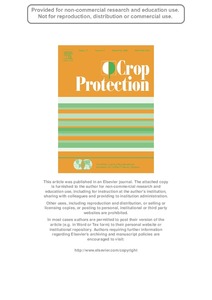| dc.contributor.author | Ngakou, A. |
| dc.contributor.author | Tamò, M. |
| dc.contributor.author | Parh, I.A. |
| dc.contributor.author | Nwaga, D. |
| dc.contributor.author | Ntonifor, N.N. |
| dc.contributor.author | Korie, S. |
| dc.contributor.author | Nebane, C.L.N. |
| dc.date.accessioned | 2019-12-04T11:14:58Z |
| dc.date.available | 2019-12-04T11:14:58Z |
| dc.date.issued | 2008 |
| dc.identifier.citation | Ngakou, A., Tamò, M., Parh, I.A., Nwaga, D., Ntonifor, N.N., Korie, S. & Nebane, C.L.N. (2008). Management of cowpea flower thrips, Megalurothrips sjostedti (Thysanoptera, Thripidae), in Cameroon. Crop Protection, 27, 481-488. |
| dc.identifier.uri | https://hdl.handle.net/20.500.12478/2889 |
| dc.description.abstract | A series of experiments were conducted in Cameroon to investigate options for managing cowpea flower thrips, Megalurothrips
sjostedti, via arbuscular mycorrhiza fungi, rhizobia and Metarhizium anisopliae. Six cowpea fields were established in three agroecological
zones over a 3-year period. The abundance of both larvae and adults of M. sjostedti was assessed on plants grown from (1) seeds
co-inoculated at sowing with arbuscular mycorrhiza fungi (AMF) and rhizobia (mycorrhiza/rhizobia); (2) non-inoculated seeds and
plants sprayed three times with M. anisopliae (Metarhizium); (3) seeds co-inoculated at sowing with AMF and rhizobia and plants
sprayed three times with M. anisopliae (mycorrhiza/rhizobia/Metarhizium); (4) non-inoculated seeds and plants sprayed three times with
the synthetic insecticide deltamethrin; and compared with (5) a control consisting of non-inoculated seeds and unsprayed plants. Results
indicate that thrips infestation was associated with the flowering cycle and was higher in the first than in the second cropping season in
most agroecological zones. In general, M. sjostedti larval and adult counts were significantly higher (Po0.01) in the control than in other
treatments. Compared with the control, treatment insecticide obtained the highest reduction of adults (range 52–95%) and larvae thrips
population (64–97%), followed by mycorrhiza/rhizobia/Metarhizium (29–56%) and (29–49%), mycorrhiza/rhizobia (31–49%) and
(24–52%), and Metarhizium (25–58%) and (5–52%), respectively. In all of the above treatments, the reduction of thrips led to a
subsequent increase of seed yield, although it was not always significant. Apart from two cases (Ngaounde´re´ 2000 and Nkolbisson 1999),
biological treatments (Metarhizium, mycorrhiza/rhizobia and mycorrhiza/rhizobia/Metarhizium) consistently reduced grain yield loss in
the trials compared with the control at Ngaounde´re´ in 1999 and Maroua 2001. These results are discussed in the context of sustainable
management of M. sjostedti populations on cowpea.
r 2007 Elsevier Ltd. All rights reserved. |
| dc.language.iso | en |
| dc.subject | Megalurothrips Sjostedti |
| dc.subject | Arbuscular Mycorrhizal Fungi |
| dc.subject | Rhizobia |
| dc.subject | Metarhizium Anisopliae |
| dc.subject | Agroecological Zones |
| dc.title | Management of cowpea flower thrips, Megalurothrips sjostedti (Thysanoptera, thripidae), in Cameroon |
| dc.type | Journal Article |
| dc.description.version | Peer Review |
| cg.contributor.affiliation | Université de Ngaoundéré |
| cg.contributor.affiliation | International Institute of Tropical Agriculture |
| cg.contributor.affiliation | Université de Dschang |
| cg.contributor.affiliation | Université de Yaoundé |
| cg.contributor.affiliation | University of Buea |
| cg.coverage.region | Africa |
| cg.coverage.region | Central Africa |
| cg.coverage.region | West Africa |
| cg.coverage.country | Cameroon |
| cg.coverage.country | Benin |
| cg.isijournal | ISI Journal |
| cg.authorship.types | CGIAR and developing country institute |
| cg.iitasubject | Pests Of Plants |
| cg.iitasubject | Plant Production |
| cg.iitasubject | Plant Diseases |
| cg.iitasubject | Disease Control |
| cg.iitasubject | Farm Management |
| cg.iitasubject | Food Security |
| cg.iitasubject | Handling, Transport, Storage And Protection Of Agricultural Products |
| cg.accessibilitystatus | Limited Access |
| local.dspaceid | 93990 |
| cg.identifier.doi | http://dx.doi.org/10.1016/j.cropro.2007.08.002 |

